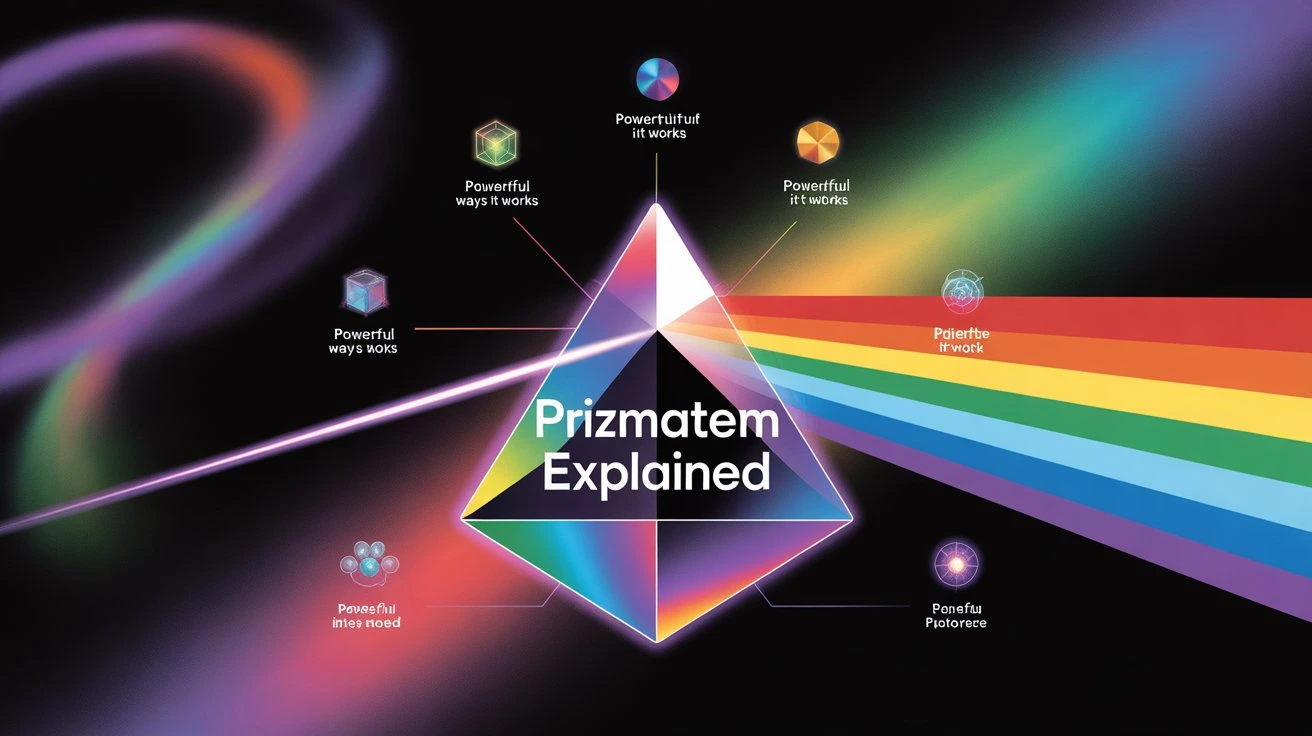Imagine trying to align thousands of data points, workflows, or visual references in a chaotic system. That’s where prizmatem enters the picture. In an era where complexity is the norm and precision is non-negotiable, professionals are turning to technologies that bridge understanding and execution. Among the most discussed and yet enigmatic tools is prizmatem, a concept that has quietly transformed how we approach alignment, visualization, and integration. Whether you’re a developer, educator, analyst, or creative, this tool has something subtly powerful to offer.
The Origin of Prizmatem
The word “prizmatem” doesn’t appear in classical literature or historical texts — and for good reason. It’s a relatively new construct, born at the intersection of data visualization, modular system design, and meta-level process automation. Although its exact linguistic roots remain debated in niche forums, the idea was reportedly first drafted during collaborative research between cross-disciplinary digital technologists and systems architects.
What began as an experiment in visualizing workflow dependencies soon became a standalone concept. The flexibility embedded in prizmatem’s design encouraged the open-source community to explore it further, evolving its original intent into multiple modular applications.
What Is Prizmatem?
At its core, prizmatem is a modular, semi-visual alignment system used for mapping abstract or complex relationships in a format that enhances clarity and interconnectivity. Think of it as a “prism” — splitting complex processes into visible, understandable layers. Its strength lies in abstraction: users can break down intricate systems into intelligible fragments, rearrange them, and then recompile them into optimized workflows.
Unlike traditional workflow mapping tools, it isn’t bound by rigid hierarchies. It’s dynamic. It adapts to logic trees, relational mapping, and iterative development without losing sight of cohesion.
Why Prizmatem Matters Today
We live in a knowledge economy. Whether we’re solving engineering problems, optimizing digital marketing campaigns, or redesigning educational syllabi — systems are increasingly interconnected. Prizmatem answers the demand for clarity without oversimplification.
With the rise of remote collaboration and cross-border project teams, having a shared “visual language” like prizmatem helps teams stay aligned. It enables real-time system modeling, cross-functional scenario testing, and micro-level revisioning — all within the same framework.
How Prizmatem Works
Instead of operating in a linear sequence, prizmatem follows a nodal structure — each concept or task becomes a node, and connections are drawn dynamically between them. Think of it like a mind-map on steroids, combined with the adaptability of low-code platforms.
The brilliance lies in its contextual fluidity. When a node shifts, every related node realigns based on defined logic gates. This keeps the system updated and prevents misalignments often found in traditional Gantt charts or static flow diagrams.
Key Components of Prizmatem
To truly appreciate prizmatem, it helps to understand its primary parts:
Nodes: The fundamental units of input — tasks, data points, ideas.
Relations: Dynamic links between nodes that carry logic and dependencies.
Viewports: How the user interacts with the architecture — zoomable, editable, customizable.
Core Engine: The backend that processes connections, timing, and logic.
Bridge Modules: Integrations with tools like APIs, SQL databases, and documentation systems.
These components together form a holistic system capable of modeling anything from editorial calendars to full-stack development processes.
Common Use Cases for Prizmatem
If you think prizmatem is only for tech teams, think again. It’s making its way into sectors like:
- Curriculum planning in universities
- Workflow design in marketing agencies
- Research dependency modeling in labs
- Game narrative mapping in entertainment
- Policy development in NGOs
By adapting its visual schema, anyone who needs to see relationships can benefit.
My First Encounter With Prizmatem
I stumbled upon prizmatem during a workshop on digital transformation tools. It wasn’t even the focus — just a side mention during a session on strategic planning. But its potential grabbed me immediately.
That evening, I installed a beta build and applied it to a content strategy project I was struggling with. Within hours, dependencies I hadn’t noticed became visible. Bottlenecks were obvious. I knew right away that this tool wasn’t just useful — it was essential.
Challenges in Understanding Prizmatem
To be fair, prizmatem isn’t plug-and-play. It takes some unlearning. If you’re used to Kanban boards or flowcharts, this structure might feel overwhelming at first.
Additionally, the terminology can be niche. And without a mentor or guide, users often misconfigure early builds. But once the core logic clicks, it’s like unlocking a new layer of perception.
The Benefits of Using Prizmatem
The upsides are both tangible and intangible. For one, it enhances focus. Instead of drowning in spreadsheets or buried dependencies, everything is mapped clearly.
It also improves communication. Teams from different disciplines finally share a visual frame of reference. And it’s agile — updates propagate through the system without need for full reconfiguration.
Where Prizmatem Excels
In fast-changing environments like media planning, logistics, and software prototyping, prizmatem outperforms traditional tools. It excels in environments where nothing stays fixed and change is the only constant.
Its adaptability makes it ideal for iterative models. You can test, fail, rebuild, and reapply — all with minimal friction.
Tools That Integrate With Prizmatem
Compatibility is growing. Current integrations include:
- Notion for documentation
- Zapier for automation
- Airtable for data input
- Figma for design prototypes
These plugins extend prizmatem’s utility far beyond a standalone system.
Prizmatem in Education
In classrooms, prizmatem serves as both a teaching and learning tool. It helps instructors design adaptive lesson plans while students use it for organizing projects, papers, and timelines.
Some institutions are even using it to create course paths, ensuring that learning prerequisites are visibly respected and academic progress is logically tracked.
Prizmatem in Industry
Industrial applications are just emerging. From agile sprint modeling in software teams to factory floor process mapping, prizmatem offers a real-time schematic for optimization.
When used with sensors and IoT data, the system becomes a living document — constantly updating and guiding operations based on actual activity.
Misconceptions About Prizmatem
It’s not just a “glorified mind map.” Nor is it too complex for non-technical users. Many people assume it’s only for coders — not true. In fact, many early adopters are from non-tech backgrounds who simply wanted better clarity.
How Prizmatem Compares to Similar Tools
Compared to tools like Miro or Lucidchart, it provides more control and flexibility in logic structuring. Unlike Trello, it’s not task-centric but relationship-centric. And compared to more technical platforms like Node-RED, it’s more user-friendly.
Getting Started With Prizmatem
Start small. Choose a manageable project — say, planning a workshop. Map the tasks, identify dependencies, and start exploring node relationships.
Within days, your confidence will grow. And soon, you’ll be applying it to everything from team roles to event logistics.
Advanced Features
As you dig deeper, you’ll discover automated recalibration, AI-suggested connections, and even smart versioning. It’s like the system evolves with your understanding.
Advanced users build entire project management suites within prizmatem, complete with notifications, analytics, and integrations.
Tips for Mastering Prizmatem
Don’t rush. Learn the basics first — nodes, logic, layout. Watch community videos. Try challenges. And document your use cases — they’ll help when training others.
Joining a user group or Slack community also accelerates learning. You’ll find tips, templates, and new ways to think about your workflows.
The Future of Prizmatem
Expect more AI features, smoother UI, and tighter integrations with real-time data tools. Companies are already using prizmatem to power digital twins — virtual replicas of real-world systems — in industries from healthcare to aviation.
Security Considerations
As with any cloud-adapted platform, security matters. it uses end-to-end encryption for sensitive data. However, always follow best practices like SSO, access management, and periodic backups.
Prizmatem for Teams and Collaboration
In team environments, prizmatem shines. You can assign node ownership, track activity, and build shared repositories. The collaborative canvas becomes a source of truth — a visual contract among collaborators.
Troubleshooting Common Issues
Most hiccups stem from logic misalignment or over-nesting of nodes. The trick is to keep things simple and expand gradually. Always preview before publishing a complex setup — and keep an archive version handy.
User Stories Around Prizmatem
From a logistics coordinator in Manila to a curriculum designer in Vancouver, stories abound. One creative director shared how prizmatem saved her team 30 hours monthly by aligning asset production timelines.
These stories underscore its real-world value far better than marketing ever could.
FAQs
What is prizmatem used for?
Prizmatem is used for mapping complex workflows, visualizing relationships between tasks, and enhancing system clarity.
Is it easy to learn?
It takes some initial effort, but once the logic is understood, it becomes intuitive and highly effective.
Can prizmatem integrate with other tools?
Yes, prizmatem integrates with Notion, Airtable, Zapier, and other popular platforms.
Is it only for technical users?
No, anyone dealing with complex systems — educators, project managers, creatives — can use prizmatem.
Does it require installation?
Some versions are cloud-based; others offer desktop builds. Choose based on your needs.
Is it secure?
Yes, it uses modern encryption protocols and supports team-based access control.
Final Thoughts
At first glance, it might feel niche. But look deeper, and you’ll see that prizmatem is more than a tool — it’s a new way of thinking. Whether you use it for productivity, planning, or innovation, it rewires your approach to structure and flow.



